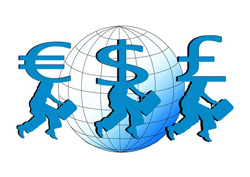 Are you thinking about setting up an e-commerce site or selling products online? If so, then you may want to think about providing your prospects with the convenience of currency conversion on your e-commerce website.
Are you thinking about setting up an e-commerce site or selling products online? If so, then you may want to think about providing your prospects with the convenience of currency conversion on your e-commerce website.
Currency conversion allows your prospects to translate international currency transactions to their local currency at the purchase or checkout stage. It also lets your visitors and customers see the exact amount their card or PayPal account will be charged, displayed in their own home currency.
One great advantage of adding currency conversion is that it allows customers to view and understand pricing in foreign countries in their own home currency, making it it easier for purchasers to calculate their costs and expenses.
If your site is powered by WordPress, it’s simple to add currency conversion using a plugin to WordPress, allowing your visitors to easily work out the cost of your goods.
Currencyr
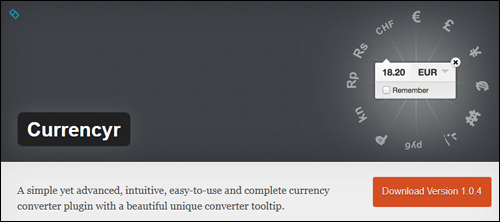
Currencyr is a simple yet advanced, intuitive, easy-to-use and complete currency converter plugin with a visually attractive converter tooltip. Best of all, it’s free!
Great plugin features include the following:
- Inline converter
- Supports various exchange rates providers, like Yahoo! and Open Exchange Rates
- Support database cache driven for fast response
- Widgetized currency table and converter
- Supports integration with a number of online store plugins such as WooCommerce, WP-eCommerce, Shopp, and Easy Digital Downloads.
- Automatic local currency detection
- Supports full language translations
Important: This plugin needs PHP 5.3.0 or later. Do not use this plugin if you are running an older version of PHP. Ask your webhosting provider to check and upgrade your PHP.
***
You can install the currency conversion plugin from your WordPress admin area by typing in “currencyr” into the Plugins search field and clicking “Install Now” …
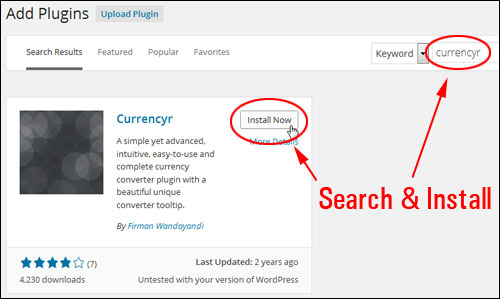
After installing and activating the plugin, you can access the plugin’s settings page by choosing Currencyr from your administration area …
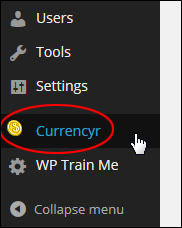
This takes you to the plugin settings page …
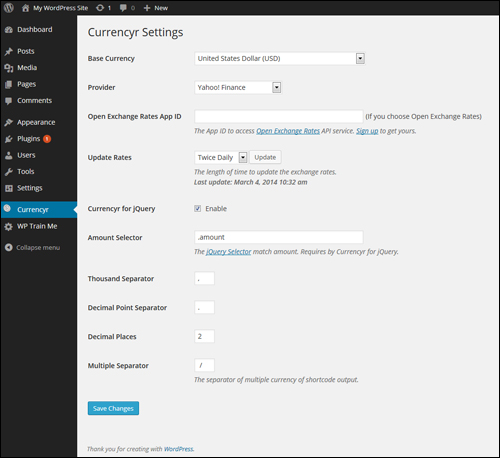
For example, you can choose a base currency from the ‘Base Currency’ drop-down menu if you want a different currency than the default option ’United States Dollar’ …
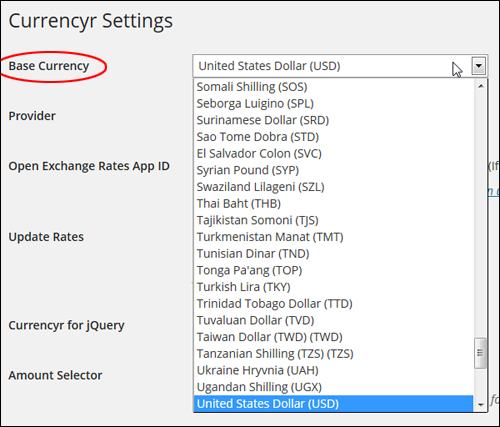
You can also choose any supported data provider from a drop-down menu. The default option is Yahoo Finance, but you can also select another provider, such as FoxRate or Google Finance …

Note: If you select Open Exchange Rates, you will need an API (Application Programming Interface) ID …

You can specify how often you want to update the currency exchange rates by selecting an option from the Update Rates dropdown menu …

The Currencyr plugin uses jQuery, which is an open-source library of Javascript code that allows web developers to add things like animation effects to web applications (like WP plugins).
If you have no reason to change the jQuery settings, leave them as they are …

Configure the remainder of the settings and remember to click Save Changes when done …
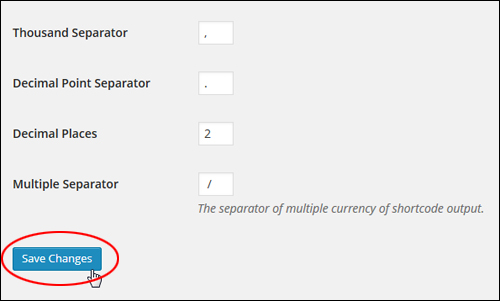
When your plugin settings have been configured, you can easily start adding currency conversion to any WP post or page using a shortcode.
Refer to the ‘Additional Plugin Notes’ section below to learn more about using currency codes (e.g. USD, NZD, JPY, etc …) in the Currencyr plugin.
Currencyr Shortcodes
You can insert currency conversion into posts, pages and widgets with no technical skills using shortcodes.
Let’s take a look at some examples of currency shortcodes that you can add to your WP pages and posts:
Let’s say that you are selling a product online for a fixed amount (e.g. $175) in US Dollars (USD), and you would like to display the conversion amount in British pounds (GBP) on your product sales page.
To do this, simply add the following shortcode to your page content …

Note: You can also display amounts in dollars and cents (for example, 19.95, 37.95, 1356.87, etc …)
The screenshot below shows how the above shortcode looks after being added to the post …
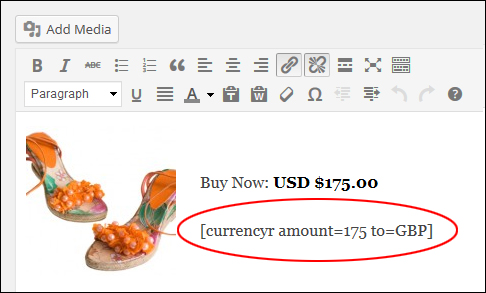
After the information has been published, the currency conversion will appear as shown in the screenshot below …
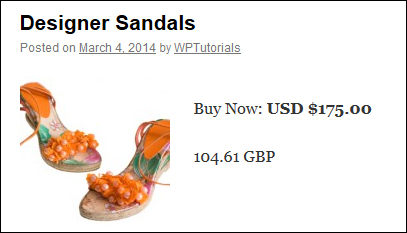
Using this example, let’s also convert the same amount into multiple currency formats.
To do this, use following shortcode (you can add as many currency symbols as you want separated by vertical pipes) …

The example below now shows how the above shortcode appears when added to a post …

After publishing the post or page, the converted currency will then appear like this …
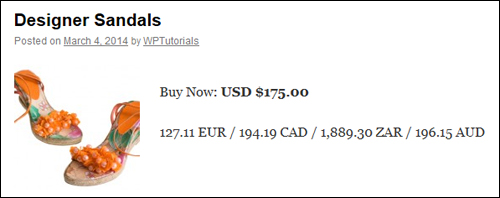
refer to the ‘Additional Plugin Notes’ section at the end of this tutorial to learn more about changing the currency separator symbol in the Currencyr plugin.
Now, let’s suppose that you would like to use a different base currency than the one you have set as your default.
For example, say you have set your default base currency as EUR and you have a section on your e-commerce pages targeted to non-European customers (like Australia or Canada), you can change the base currency using the following shortcode …

Here’s how the shortcode appears when added to a post …
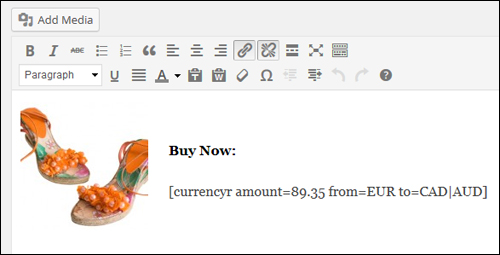
After publishing your content, your currency conversion will then display like this …
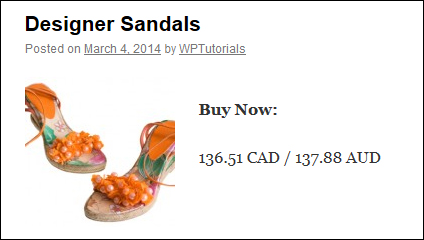
Using The Currencyr Widget
You can also insert currency conversion into your website’s sidebar area using the Currencyr widget.
To add the currency converter to your sidebar area, choose Appearance > Widgets from your WP user admin menu …
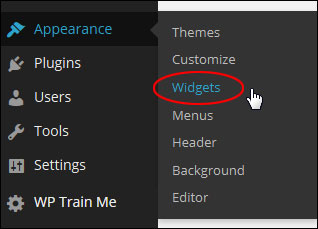
In the Widgets > Available Widgets area find the ‘Currencyr’ widget and drag it to the Active Widgets location …
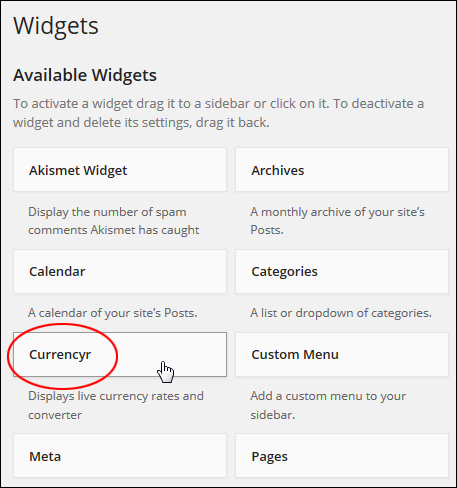
Configure the widget options as shown below (add currency codes separated by commas), and click Save to update your settings …
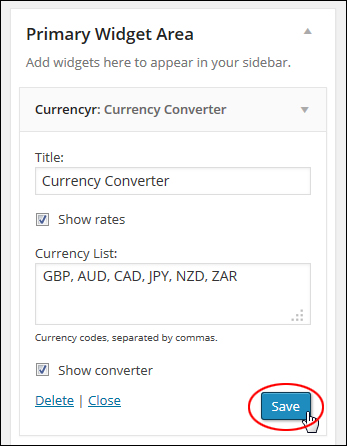
Your currency converter tool will now appear on your website’s sidebar with the settings you have selected …
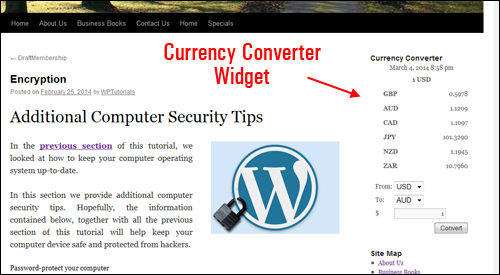
Additional Plugin Notes
Here are some additional notes and useful information about using the plugin.
Currency Separator
The Currencyr plugin lets you specify a symbol of your choice to display as the currency separator when using multiple currencies.
You can select a different symbol in the Multiple Separator settings section.
So, for example, entering the default symbol “/” (forward slash) …

Separates all your currency amounts with the forward slash as shown below …
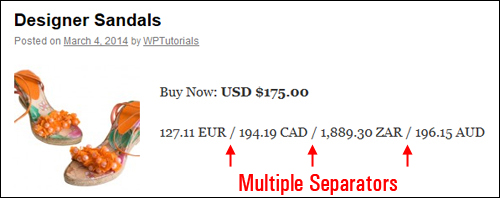
If you specify another symbol and resave your settings …

Your web site visitors will see the new symbol display as the currency separator …
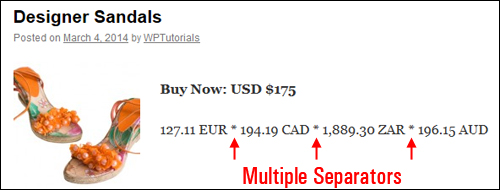
E-Commerce Platform Integration
As stated earlier, the plugin can be integrated with a number of WP-compatible e-commerce plugins such as WooCommerce, WP-eCommerce, Shopp, and Easy Digital Downloads …
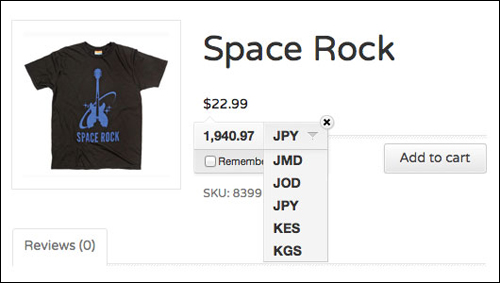
(above image sourced from plugin site)
Congratulations! Now you know how to easily add currency conversion to your e-commerce website.
To learn more about WordPress e-commerce plugins, see the tutorial below:
***
"This is an awesome training series. I have a pretty good understanding of WordPress already, but this is helping me to move somewhere from intermediate to advanced user!" - Kim Lednum